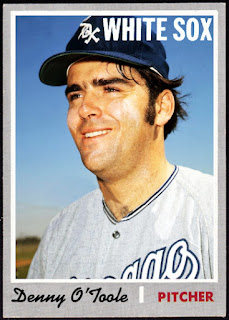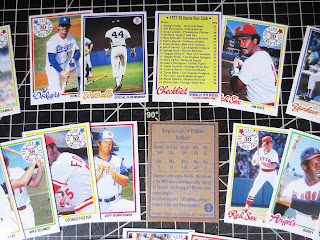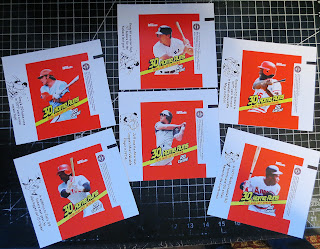Capping off yet another week here on the blog, today we have the next card in my "expanded league leaders" thread, a 1974 N.L. Stolen base leader card, featuring the top three stolen base guys from the Senior Circuit for 1973:
Sunday, October 31, 2021
EXPANDED LEAGUE LEADERS: 1974 N.L. STOLEN BASES
Saturday, October 30, 2021
NICKNAMES OF THE 1970'S: "BULLDOG" JIM BOUTON
Time to post up a long overdue "nicknames of the 1970's" card for former pitcher Jim Bouton, aka "Bulldog", for now in a Seattle Pilots 1970 edition until I can find a nice shot of him with the Houston Astros that I haven't used before:
While with the Yankees he had two great seasons in 1963 and 1964 before arm injuries kept him sporadic at best over the next four years.
As a Seattle Pilot, Bouton was used as a reliever, appearing in 57 games while going 2-1 with an earned run average of 3.91 before getting traded to the Houston Astros on August 24th of ‘69, where he appeared in 16 games before the season was done.
Of course, his somewhat brief tenure with the Pilots is forever immortalized in his landmark book “Ball Four”, with anecdote after anecdote of players, coaches and managers throughout his MLB career, and the Pilots had their fair share of characters.
For Bouton, he’d also pitch in 1970 before arm troubles ended his career, but not before making a surprising comeback at the age of 39 with the Atlanta Braves in 1978, appearing in what turned out to be the last five games of his career, all starts, as he went 1-3 with a 4.97 ERA.
All told, Bouton finished his career with a record of 62-63, with an ERA of 3.57 over 304 appearances, 144 of those starts, with 11 shutouts and six saves between 1962 and 1979.
Friday, October 29, 2021
1972 ALL-STAR SUB-SET: BUDDY HARRELSON
Next up in my on-going 1972 All-Star sub-set is the starting shortstop for the National League in the classic 1971 Midsummer classic, New York Met Bud Harrelson:
Thursday, October 28, 2021
TRADED: 1977 CLAUDELL WASHINGTON
On the blog today, we have a 1977 "Traded" card for former outfielder Claudell Washington, who found himself heading to the Texas Rangers just before the 1977 season after a trade from the Oakland A's:
Wednesday, October 27, 2021
REVISITING AN OLD BLOG POST- JULY 13TH, 2013
With the passing of former Major League pitcher Chuck Hartenstein this past October 2nd, I thought I'd revisit a really old post from the blog covering his unlikely return to the Big Leagues in 1977 after seven years.
Luckily for some reason I flipped the card around and looked at the stats posted, and saw that this guy hadn't appeared in a Major League game since 1970. So of course, I look up when he last appeared on a baseball card and saw that it was also in 1970.
Amazing actually, that a guy has a span of seven years between baseball cards as an active player. The only other time I can recall this happening is with pitcher Vicente Romo, who went between 1975-1983 without a card.
Thanks to baseball's expansion with the Mariners and Blue Jays, there was a sudden need for some "extra" players in 1977, especially some cheap, unprotected veterans and cast-offs who could fill some roles on the bench and in the bullpen.
Apparently the Toronto brass felt Hartenstein was one of these guys, even if his earlier career wasn't necessarily stellar.
Pitching from 1966-1970, Chuck sported an even 17-17 record as an arm out of the pen over 174 games for the Cubs, Cardinals, Pirates and Red Sox with a 4.52 E.R.A.
As for his return to the big leagues, it wasn't much to look at, posting an 0-2 record with a 6.59 E.R.A. in 13 games.
But hey, at least it was good for a nifty, groovy-looking card that only the '70's could offer.
I'm still trying to see if I uncover any other cards of guys who had a long span between issues but can't seem to find any. Anyone know of any others?"
Tuesday, October 26, 2021
NOT REALLY MISSING IN ACTION- 1975 RICH McKINNEY
Time to add a "not so missing" 1975 card for former Major League infielder Rich McKinney to the WTHBALLS stable, the third creation here over the years for the guy:
When it was all said and done, McKinney finished with a .225 batting average, with 199 hits in 886 at-bats over 341 games, with 20 homers and exactly 100 runs batted in and 79 runs scored.
Of course we’ll also remember that McKinney got two straight classic airbrush jobs on his Topps cards in 1972 and 1973, which I profiled years ago on the blog:
http://whentoppshadballs.
Monday, October 25, 2021
NOT REALLY MISSING IN ACTION- 1979 OSCAR ZAMORA
On the blog today, a career-capping "not so missing" 1979 card for former pitcher Oscar Zamora, who played the last games of his brief Major League career during the 1977 season:
Sunday, October 24, 2021
EXPANDED LEAGUE LEADERS: 1974 A.L. RUNS BATTED IN
Saturday, October 23, 2021
1972 ALL-STAR SUB-SET: GLENN BECKERT
Next up in my new thread celebrating the greatest All-Star game of the 1970's, if not ever, is my 1972 All-Star card for the National League's starting second baseman for the 1971 Midsummer Classic, Glenn Beckert of the Chicago Cubs:
Friday, October 22, 2021
MISSING IN ACTION- TEAM VARIATION: 1975 DERON JOHNSON
On the blog today, we have a "missing" 1975 for Deron Johnson, but it is an alternate version, showing him as a Milwaukee Brewer, the second of three teams he'd suit up for in 1974:
Thursday, October 21, 2021
GIMMIE A DO-OVER: 1978 DOC MEDICH
Here's a fun card to throw out there, a re-do for Doc Medich and his 1978 Topps card, showing him with a team he pitched for in 1977 instead of the airbrush classic that we all pulled out of packs in the Spring of 1978:
Wednesday, October 20, 2021
NOT REALLY MISSING IN ACTION- 1971 WAYNE TWITCHELL
Up on the blog today we have a "not so missing" 1971 card for former pitcher Wayne Twitchell, who made his MLB debut in 1970 as a member of the Milwaukee Brewers:
Tuesday, October 19, 2021
DEDICATED MANAGER CARD- 1975 BILLY MARTIN
Time to go and give one of my favorite baseball personalities, Billy Martin, a "dedicated manager card" in my new thread, this one a 1975 edition:
He would move on to Detroit, and would take them to a first place finish by his second year in 1972 with a record of 86-70.
He’d move on to the Texas Rangers and they’d have their first successful season in 1974, albeit a second place finish behind league MVP Jeff Burroughs and ace Fergie Jenkins, then of course he would move on to the New York Yankees, where the “Bronx Zoo” was in full swing, eventually bringing Martin a World Championship in 1977.
He’d move on to the Oakland A’s where “Billy-Ball” was in full effect, losing to the Yankees in the Championship Series while burning through every arm on his pitching staff with overuse.
Then finally, there was the back-and-forth period between he and the Yankees, specifically owner George Steinbrenner, where he managed in 1983, 1985 and finally 1988, almost a comedic show of hiring and firing that really was an embarrassment to us Yankee fans of the era.
Nevertheless, Martin was a winner, though one with a temper at that, leaving the game with a .553 winning percentage and over 1200 wins.
Should he be in the Hall of Fame?
I do think so more for his personality than anything else. As a symbol of the wild 1970’s with his managerial style a'la Earl Weaver, arguing and fighting his way through each season.
Rest in Peace Billy, you are missed.
Monday, October 18, 2021
NOT REALLY MISSING IN ACTION- 1973 JIM MERRITT
Getting a little "cheeky" today with a "not so missing" 1973 card for former 20-game winner Jim Merritt, who found himself struggling in the Big Leagues just two seasons after a banner year in 1970:
I say “arguably” because that year his earned run average was a high 4.08, while in 1967 with the Twins he went 13-7 with a wonderful 2.53 ERA over 37 appearances, 25 of those starts, tossing a career-high four shutouts with 161 strikeouts.
Overall, he’d finish his career with a record of 81-86, posting an ERA of 3.65 over 297 appearances and 1483 innings of work, throwing nine shutouts while collecting seven saves along the way.
Sunday, October 17, 2021
EXPANDED LEAGUE LEADERS- 1974 N.L. RUNS BATTED IN
On the blog today, we move ahead in my long-running "expanded league leaders" thread where we celebrate the top 3 men in a particular statistic in years where Topps just had the first place finisher of both leagues on one card.
Saturday, October 16, 2021
1972 ALL-STAR SUB-SET: WILLIE McCOVEY
On the blog today, we move on to the National League's starting first baseman in the classic 1971 All-Star game, "Stretch" Willie McCovey:
Friday, October 15, 2021
DEDICATED MANAGER CARD- 1976 GENE MAUCH
Thursday, October 14, 2021
NOT REALLY MISSING IN ACTION- 1972 BOB KAISER
On the blog today we have a fun card to add to the "WTHBALLS" stable, a "not so missing" 1972 card for one-year Big League pitcher Bob Kaiser, he of five games in 1971 for the Cleveland Indians:
Wednesday, October 13, 2021
NOT REALLY MISSING IN ACTION- 1979 MIKE GORDON
On the blog today, we have a "not so missing" 1979 card for former Chicago Cubs catcher Mike Gordon, who put in parts of two seasons in the Big Leagues in 1977 and 1978:
All told, he finished his MLB career with a .071 average, with two hits in 28 at-bats with a couple of runs batted in.
Tuesday, October 12, 2021
TRADED: 1978 BOBBY BONDS (PART 2)
Years ago on the blog I created a 1978 "traded" card for Bobby Bonds, showing him as a member of the Chicago White Sox after coming over from the California Angels.
Monday, October 11, 2021
NOT REALLY MISSING IN ACTION- 1970 DENNY O'TOOLE
On the blog today, we have a "not so missing" 1970 card for a guy who will have a few created for the blog over the years, former Chicago White Sox pitcher Denny O'Toole:
Sunday, October 10, 2021
EXPANDED LEAGUE LEADERS- 1974 A.L. HOME RUNS
Next up in my on-going thread of "expanded league leaders_ is my 1974 American League Home Run card, celebrating the top three home run hitters in the Junior Circuit for 1973:
Saturday, October 9, 2021
1972 ALL-STAR SUB-SET: JOHNNY BENCH
Today we start a fun new thread, celebrating one of the greatest All-Star games, the 1971 Midsummer Classic, with a special 1972 All-Star subset, beginning with the National League catcher, Johnny Bench of course:
Friday, October 8, 2021
NOT REALLY MISSING IN ACTION- 1975 ORLANDO ALVAREZ
On the blog today, a "not so missing" 1975 card for Orlando Alvarez, who played parts of four seasons, including two games for the Los Angeles Dodgers in 1974:
Thursday, October 7, 2021
TRADED- 1978 BILL NORTH
On the blog today, a 1978 traded card for former speedster Bill North, who found himself heading South to the Los Angeles Dodgers from the Oakland A's about a month after the 1978 season started:
Wednesday, October 6, 2021
NEW CUSTOM SET: 1978 "30 HOME RUN CLUB"
Hello Everyone!
Hope you're all fine and well!
NOT REALLY MISSING IN ACTION- 1975 CHUCK SEELBACH
Up on the blog today, a " not so missing" 1975 card for former Detroit Tigers pitcher Chuck Seelbach, who turns out played the last of his Big League games during the 1974 season:
And just like that his Big League career was over.
His four years as a pitcher resulted in a career 10-8 record, with a 3.38 ERA over 75 games, with 14 saves and 130.2 innings pitched.
Tuesday, October 5, 2021
REVISITING AN OLD BLOG POST- DECEMBER 30TH, 2013
Thought it'd be fun to revisit an old post from the blog from about eight years ago, dealing with my imagined 1975 "Cy Young" sub-set mimicking the MVP sub-set, then going one further by citing an old SABR article from a 1993 journal guessing at who would have won the award before it's inception in 1956.
Here's a closer look at the "created" cards for this post:
Monday, October 4, 2021
NOT REALLY MISSING IN ACTION- 1973 GENE HISER
On the blog today, the third "not so missing" card created for former Chicago Cubs outfielder Gene Hiser here on the blog, this one a 1973 edition:
Sunday, October 3, 2021
EXPANDED YEARLY LEADER CARDS: 1974 N.L. HOME RUNS
On the blog to close out another week, we have an expanded league-leader card in the 1974 set celebrating the top-3 home run hitters in the National League for 1973:
Saturday, October 2, 2021
DEDICATED MANAGER CARD- 1977 SPARKY ANDERSON
Thought I'd start creating some "dedicated" manager cards through the decade for the years Topps didn't create any, since so many of these guys were iconic figures in the game during some great years.
FOLLOW ME ON TWITTER...
Everything baseball: cards, events, history and more.






































